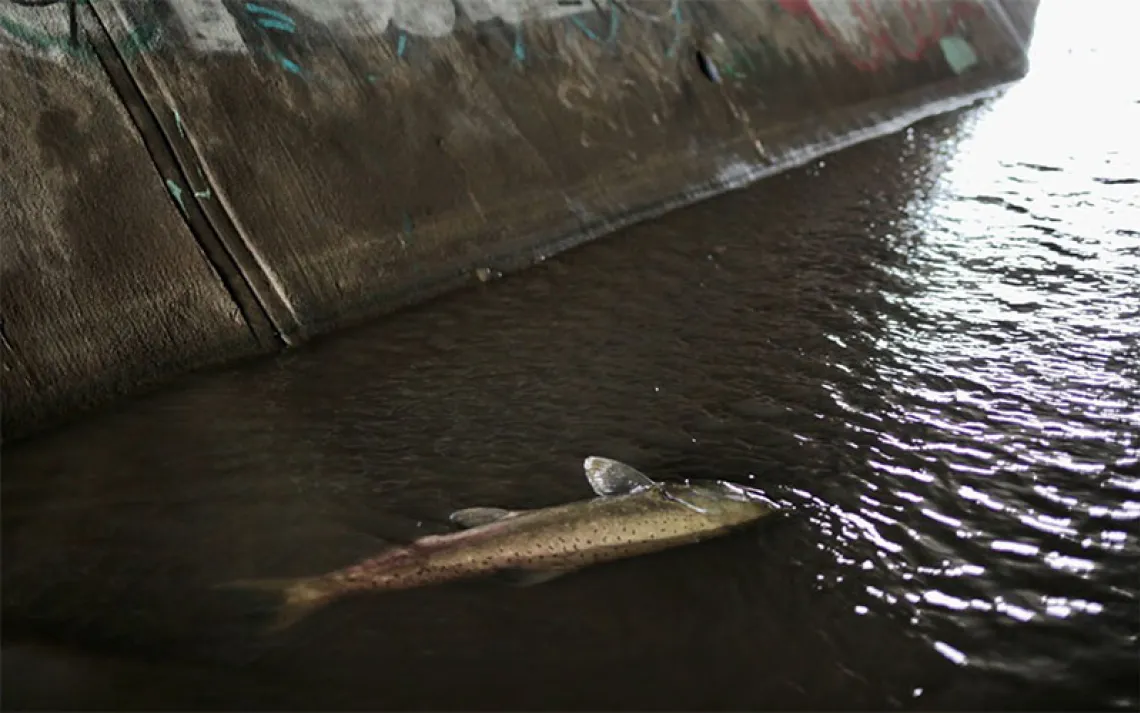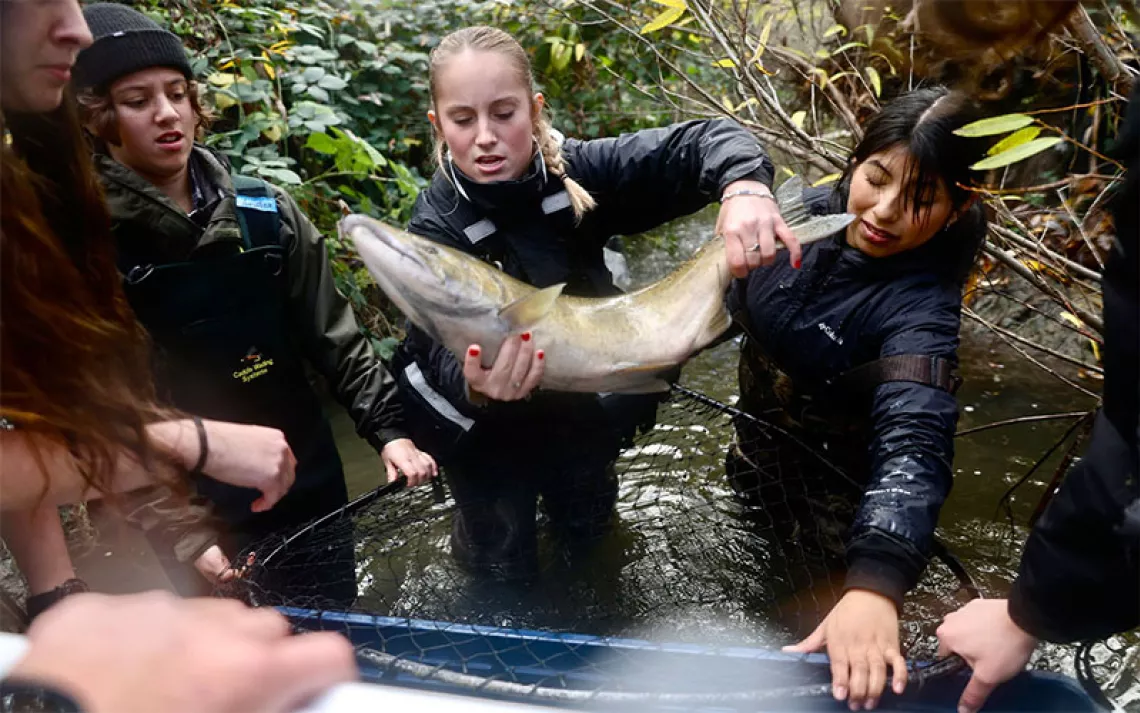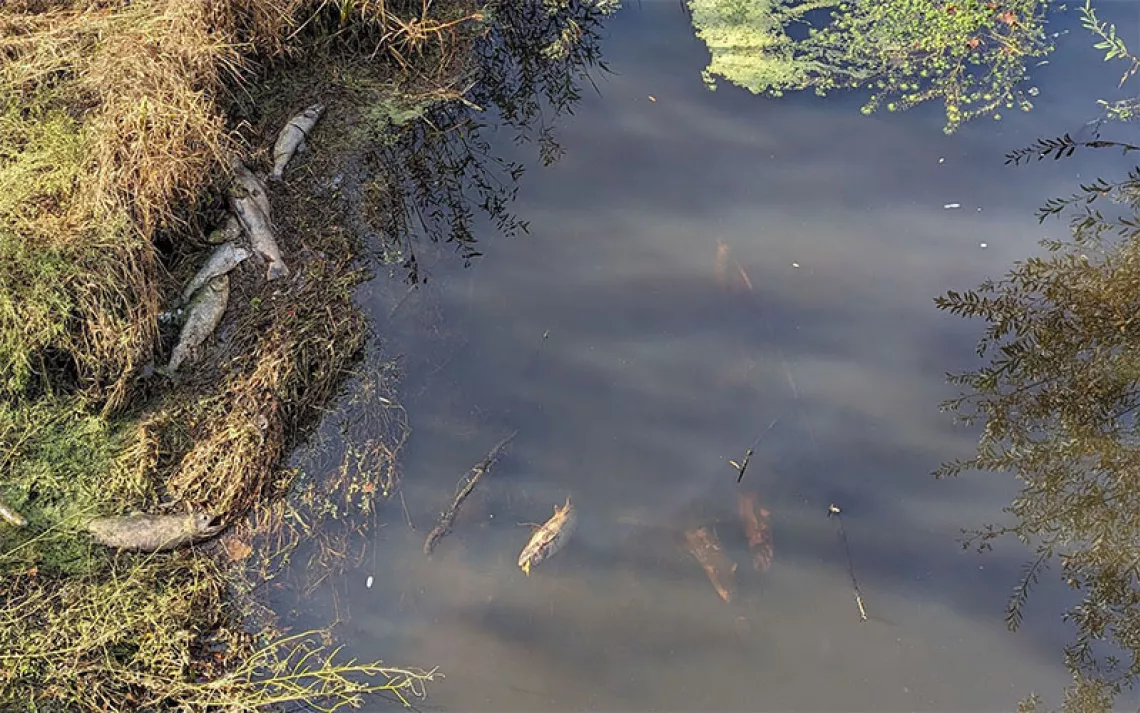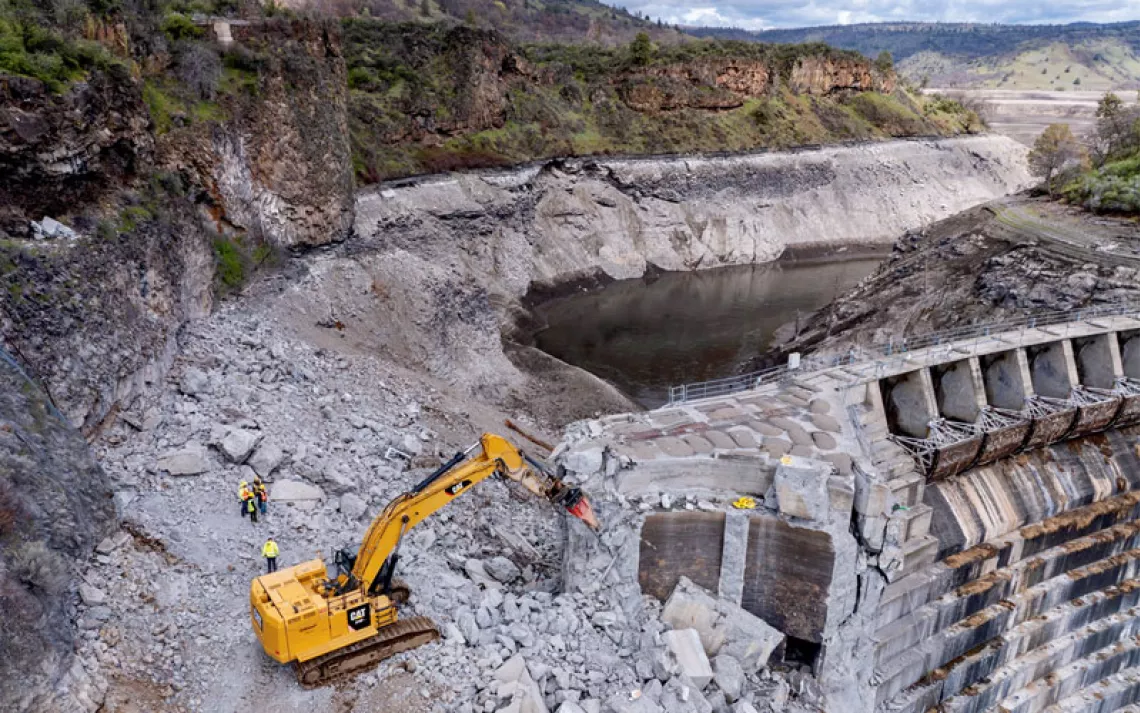Volunteer Trout Wranglers Save Central California’s Steelhead
Saving an iconic species is as easy as moving them from one place to another

A group of rescued young steelhead in the Carmel River swim free after being released in a lagoon farther down the river. Had CRSA not moved these fish, they would have died from heat or suffocation. | Photo by Paz Gur Arye
Brian LeNeve doesn’t have much patience for people who are late. As he and a crew of five volunteers gathered in a small dirt parking lot at Garland Regional Park in the Carmel River Valley of central California, the 81-year-old seemed distracted by his watch, checking it between conversations. “We give people a 10-minute grace period before we leave,” he explained. Any longer than that, “we’re taking time away from the fish.”
LeNeve is the former president and current treasurer, conservation chair, and board member of the Carmel River Steelhead Association (CRSA), based in Monterey, California. The organization has one simple mission: Save the federally threatened South Central California Coast population of steelhead trout.
Genetically the same species as the rainbow trout, steelhead are characterized by one key difference: Unlike their freshwater counterparts, these fish spend most of their adult life in the ocean, only returning to the river where they were born to spawn. “It’s amazing to think that these fish that swim as far as Alaska come back to people’s backyards in central California,” said Eric Palkovacs, a fisheries ecologist at the University of California, Santa Cruz.
Why some fish become steelhead and others become rainbows depends on a myriad of factors. According to Palkovacs, every fish that eventually becomes a steelhead has a specific genetic mutation. But rainbow trout can have this mutation too, and they both can occupy the same streams. Whether trout with the steelhead mutation journey to the ocean can be influenced by nongenetic factors such as body size, weight, and gender. To simplify things, scientists designate populations with access to the ocean as steelhead and populations that are cut off from the ocean as rainbow trout.
Unlike steelhead, rainbow trout are not a threatened species. However, because all the fish in the Carmel River have access to the ocean, federal officials classify them as steelhead regardless of whether they make the journey or not. Unfortunately, they are in dire straits.
Due to the excessive pumping of the river for municipal water, parts of the Carmel River that once brimmed with life dry up every summer. When the river dries, young steelhead become trapped and die by the thousands from suffocation, heat, or lack of water. California steelhead populations are already threatened by dams, invasive predators like catfish and bass, agriculture, and more. Without intervention, a Carmel River die-off could lead to the end of this subspecies.
In order to avert that catastrophic outcome, LeNeve and his team take matters into their own hands, literally. Every year starting in July, organizers and volunteers go out to the upper part of the river several times a week to rescue fish, a process that entails catching trapped fish and moving them to parts of the river that continue to flow. The rescues continue until September, when the heat dies down and the river stabilizes.
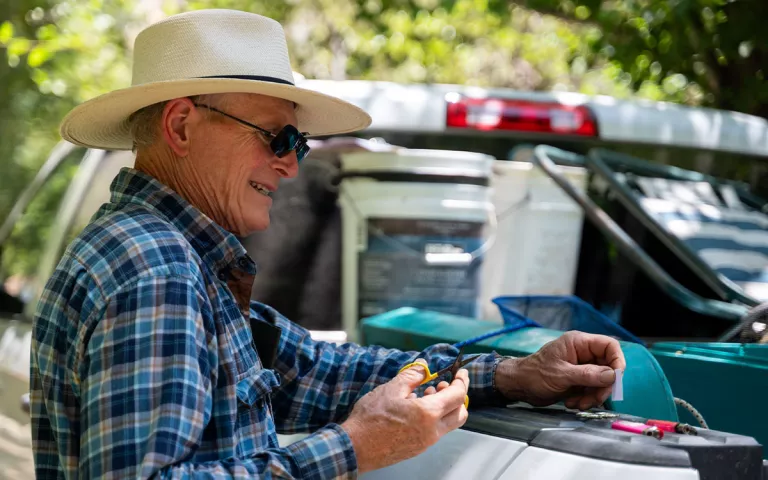
A CRSA volunteer prepares to take a tissue sample from a rescued steelhead trout. These tissue samples will go to scientists researching the genetics of steelhead and rainbow trout. | Photo by Paz Gur Arye
LeNeve was born and raised in Monterey and had known of CRSA since the 1990s but wasn’t allowed to join until 2006. “I was too much of a renegade,” he said with a smile. The renegade behavior in question was fishing in unsanctioned areas, which LeNeve justifies with the fact that he almost always releases the fish he catches.
Nowadays, LeNeve starts every rescue with the same motto: “Have fun, save fish.” And as he and a team of volunteers descended upon the upper Carmel River in a clamoring brigade of Subaru Crosstreks and pickup trucks on a hot Wednesday in early August, it’s clear everyone takes these words to heart.
“I do these rescues for the camaraderie, in a sense,” said James C. Jefferey III, known as JJ on the river. The 83-year-old CRSA board member and fish rescue regular drives a truck with the license plate KSDAFSH (“kiss the fish”). “It’s fun and it’s rewarding.”
CRSA wrangles trout using electro-fishing, which involves the usage of portable electroshock “backpacks” that transmit an electrical current into the water and stun any submerged animals nearby for a few seconds. While one person uses the electroshock backpack to stun the fish, the other team members swoop in with flat nets that look like elongated tennis rackets, scooping up the fish and dropping them into a designated bucket so that they can be examined for relocation.
This method is not without its flaws. Often, more fish escape than make it into the bucket. There can also be mortalities: If a fish is shocked for too long or too hard, their backs can break, and they die a slow death. LeNeve is quick to point out that if not for CRSA, every single one of the fish in these stretches of dry river would likely perish. Even if there are mortalities, he argues that saving some fish is better than saving none.
At a pop-up tent, fish flew in and out of buckets while a team, including Jeffrey and CRSA employee Yolanda Chen, worked to measure and weigh them before inserting passive integrated transponder (PIT) tags and dropping them into a transportation tank in the back of a pickup truck. By doing this, the team can collect information on the health of the fish and monitor them as they grow over the years. The PIT tags will flag a checkpoint set up lower in the Carmel River when the tagged fish pass by so CRSA will know whether the fish are still alive and if they are migrating to or from the ocean.
The whole fish rescue process takes just around two hours. In those two hours on this August morning, three teams of volunteers rescued 826 fish, a pretty good haul, according to LeNeve. “Once we hit a thousand, we tend to draw the line,” he explains.
When the rescue mission was completed, the group drove the fish to a breathtakingly lush spot farther down the Carmel River. Here, the team took DNA samples from the fish as they acclimated to the new water in holding buckets before releasing them into the river to continue their lives. “I get pretty romantic about it,” Steve Park, CRSA’s president, said. “Bringing them out of that terrible situation they’re in, and releasing them into this system, is just like going to church.”

Make every day an Earth Day
Get articles like this one sent directly to your inbox.
With this action you affirm you want to receive Sierra Club communications and may vote on policy designated by the Sierra Club Board.
Although many of the younger staff and volunteers have scientific backgrounds, LeNeve, Park, and many of the senior members joined CRSA because of their love for fishing, and specifically for steelhead. Each board member has their own special experience that inspired them to join CRSA’s cause. For Park, it was a fishing trip with his children on the Trinity River. For LeNeve, it was a trip to Big Sur with his dad. “Hunters and fishermen make for the best conservationists,” LeNeve said. “Yes, scientists are important, but they’re not always boots on the ground like we are.”
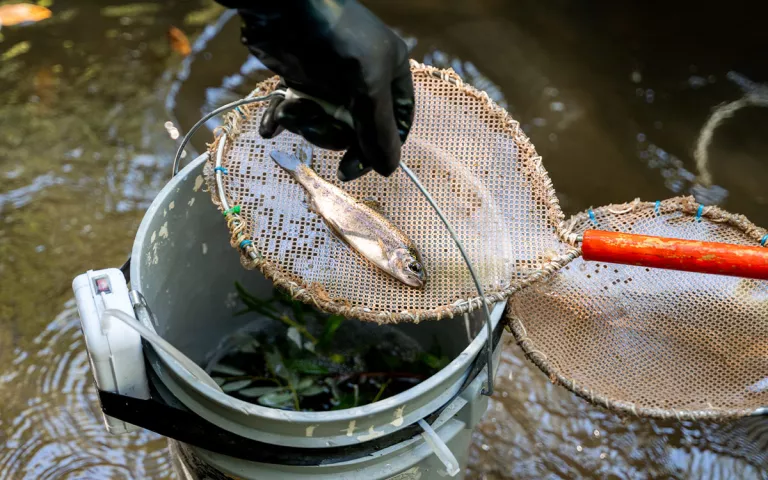
Volunteer electrofishers with CRSA place a yearling steelhead trout into a holding bucket. This trout will be measured, weighed, and tagged before being released downstream where the river will not dry up. | Photo by Paz Gur Arye
Over the years, CRSA board members have stuck up for steelhead in meetings with city planners, government officials, and even senators. Since the organization’s founding, its members have seen two dams removed from the Carmel River and woody debris added to the river to provide cover for young trout. They are currently advocating for the lagoon at the mouth of the Carmel River to be reinforced to prevent young steelhead from getting prematurely washed out to sea. “We’re just citizen scientists, as they call us,” LeNeve said. “But we’re able to voice our position and be a stakeholder, which is really important.”
Everyone at CRSA strongly believes they are making a difference in the lives of steelhead with each fish they rescue. However, not all scientists are entirely convinced. Palkovacs emphasizes that the outreach work CRSA and other fish rescue organizations do is vital to inspiring the conservation of this threatened species. But he’s concerned that the rescues themselves aren’t making the difference that CRSA celebrates.
His worry is that adding the rescued steelhead to parts of the river where there are already steelhead could lead to overcrowding, causing both the newly rescued fish and the existing fish to starve. “If you're taking fish and putting them on top of fish that are already stressed out, maybe it's worse for everybody,” he added.
LeNeve said that CRSA has done its own research on this topic through the fish rescue program and found that adding new fish lower down in the river had no negative impact on the existing fish. With all of the work CRSA and other organizations are doing, LeNeve isn’t sure whether it will be enough. Steelhead are very temperature-sensitive fish and can’t survive when water gets too hot. “If this river gets to 70-something degrees, we could lose them all,” he said.
However, Park is hopeful that with enough advocacy, the Carmel River could one day return to its former glory. “My dream is that my children’s children will be able to fish the Carmel River,” he said. “I think someday it could happen.”
 The Magazine of The Sierra Club
The Magazine of The Sierra Club
